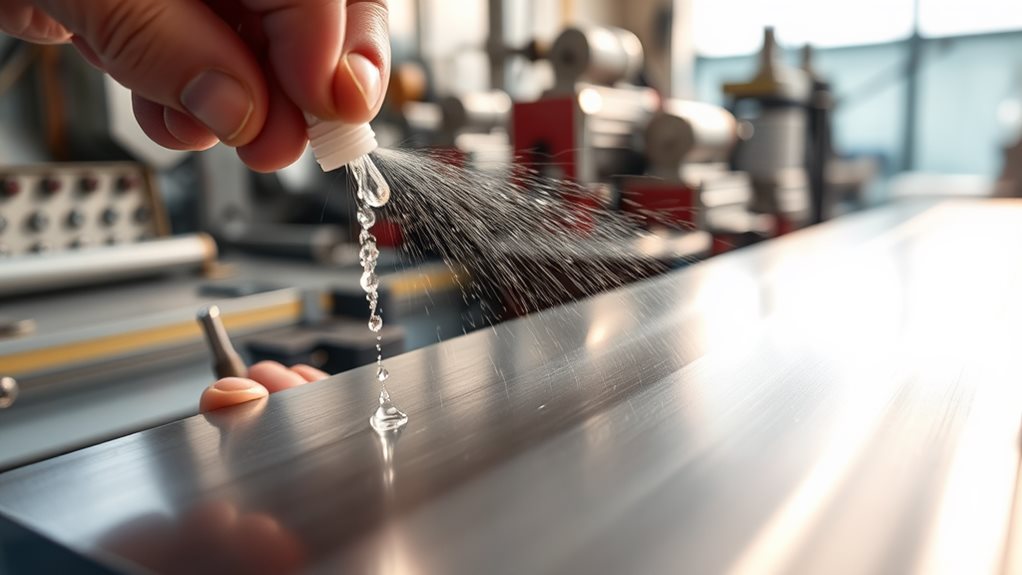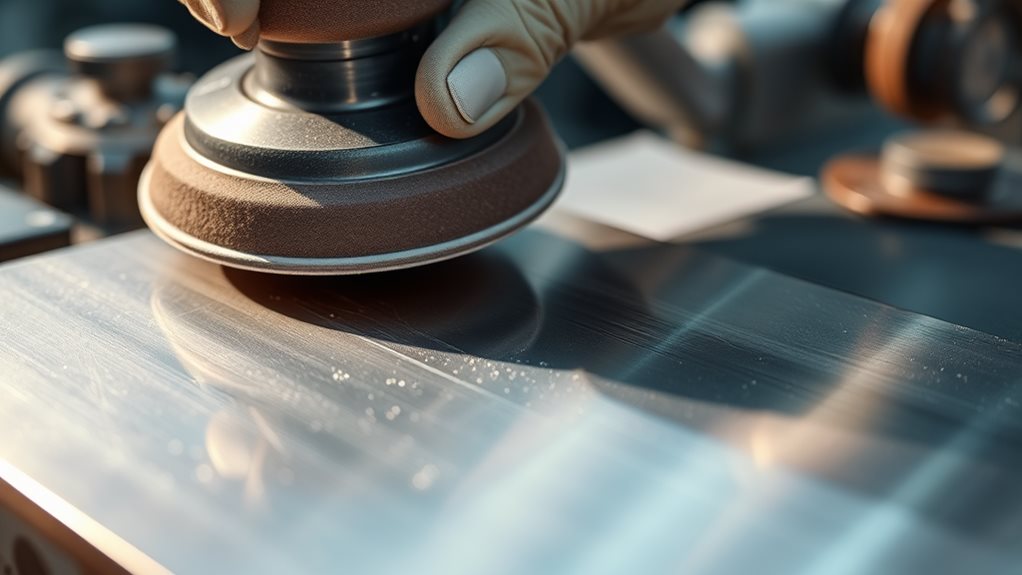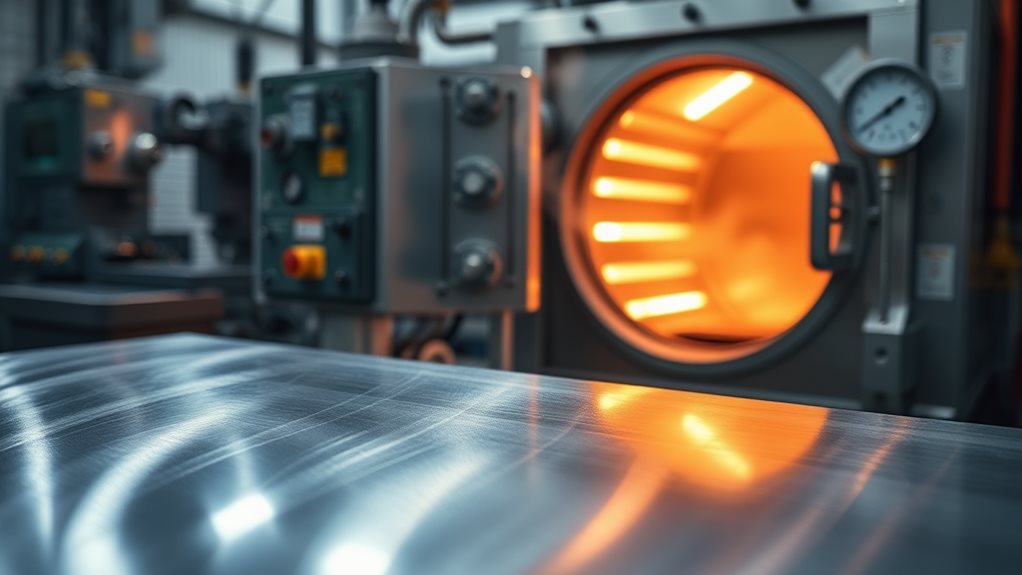How to Improve the Surface Finish of Aluminum Forgings?

To improve the surface finish of aluminum forgings, we must focus on several key factors. Initially, selecting the right alloy like 6061 can augment forgeability and yield better finishes. Maintaining ideal forging temperatures—typically between 400°C to 550°C—prevents defects and promotes smooth surfaces. We should also employ mechanical finishing techniques such as grinding and polishing, paired with chemical processes like anodizing for added corrosion resistance. Effective tooling design and lubrication methods play significant roles in achieving precision. By integrating these strategies, we’ll guarantee superior surface quality and performance, opening doors to even more advanced techniques awaiting exploration.
Key Takeaways
- Ensure proper surface preparation through alkaline cleaning to remove contaminants and enhance adhesion for finishing processes.
- Select the appropriate aluminum alloy, such as 6061, known for its excellent forgeability and smooth finish capabilities.
- Maintain ideal forging temperatures (400°C to 550°C) to prevent defects and ensure optimal plasticity during the forging process.
- Utilize mechanical finishing techniques like grinding and polishing for high precision surface improvement while minimizing scratches.
- Implement advanced finishing technologies like anodizing and electroless nickel plating to enhance corrosion resistance and surface quality.
Understanding Surface Finish Importance

When we consider the significance of surface finish in aluminum forgings, it’s clear that even minor variations can greatly impact functionality and performance. A smooth surface finish considerably reduces friction, which is essential for peak operation. By minimizing surface roughness, we improve durability and reduce wear and tear, guaranteeing that our products maintain their integrity over time. This aspect not only enhances dimensional stability but also guarantees precision and accuracy during manufacturing processes. Furthermore, employing mechanical finishing methods ensures that the surface is adequately prepared for further treatments, enhancing overall quality. Additionally, the tight, aligned grain pattern achieved through the forging process plays a crucial role in ensuring a superior surface finish. The forging process itself contributes to a refined microstructure, which ultimately leads to enhanced mechanical properties.
Moreover, a better surface finish leads to lower maintenance costs, as it decreases the likelihood of wear. Improved surface quality also contributes to corrosion resistance; smooth surfaces reduce moisture accumulation and prevent crevices and cracks that can cause corrosion. The superior grain structure achieved through the forging process significantly contributes to this enhanced surface quality.
In our quest for quality assurance, we must prioritize achieving consistent surface finishes that meet industry standards. By incorporating advanced surface finishing techniques, we can improve product quality and performance, ultimately leading to greater customer satisfaction.
Selecting the Right Alloy

When selecting an aluminum alloy, we must consider how its properties impact the final surface finish. The elemental composition and grain structure play vital roles in determining the quality of the finish, while forging temperature can further influence the outcome. Additionally, the selection of a suitable alloy can significantly enhance the overall performance of the surface treatment processes applied. Ensuring that the chosen alloy undergoes pre-processing checks can further minimize the risk of defects and ensure a higher quality surface finish. Furthermore, different alloys exhibit varying forging characteristics that can influence the surface quality achieved during manufacturing. Choosing an alloy with high strength-to-weight ratio can also contribute to improved surface integrity in forged components.
Alloy Properties Impact Finishing
Selecting the right aluminum alloy is crucial for achieving ideal surface finishes in forgings. The properties of different alloys directly impact our finishing processes and the final quality of the product.
For instance, alloy 6061, known for its alloy flexibility and excellent forgeability, can achieve smoother surface finishes due to its malleability. In contrast, alloy 7075, with its high strength-to-weight ratio, is better suited for high-stress applications, but may require more intensive finishing techniques to improve surface durability.
Moreover, alloy 6082 provides notable corrosion resistance and minimal deformation after hot forging, making it a strong candidate for applications where both appearance and performance are critical. This is particularly important since surface finishing enhances performance by improving durability and resistance to elements.
Each alloy’s unique characteristics necessitate customized finishing approaches, whether that involves machining, grinding, or chemical treatments like anodizing.
The choice of alloy must align with the intended application and desired surface finish. By considering factors such as mechanical properties and responsiveness to thermal treatments, we can guarantee that the selected alloy not only meets performance requirements but also achieves the surface quality we aim for in our aluminum forgings.
Forging Temperature Considerations
The choice of forging temperature greatly influences the surface finish and mechanical properties of aluminum forgings. We must recognize that the ideal forge temperature typically ranges between 400 ℃ and 550 ℃, where the material’s flowability and plasticity markedly improve. This improvement leads to a smoother surface finish, vital for achieving desired surface integrity.
However, we should also be cautious; temperatures that are too low may result in poor plasticity and uneven forging, while excessively high temperatures can introduce internal porosity and surface oxidation.
Different aluminum alloys have unique forging temperature requirements based on their chemical compositions. High-strength alloys, for instance, often have narrower temperature ranges and are more sensitive to fluctuations. It’s fundamental to maintain these ideal temperatures to prevent defects such as cracks and uneven surfaces, which can compromise the mechanical properties.
Furthermore, we need to take into account the equipment used in the forging process, as it can affect the actual workpiece temperature. By controlling the die temperature and adjusting the forging parameters, we can guarantee that we consistently produce high-quality aluminum forgings with excellent surface finishes and mechanical integrity.
Optimizing Forging Temperature

To improve the forging temperature, we need to understand the ideal temperature range for specific aluminum alloys.
The temperature greatly influences surface quality, as higher temperatures generally yield a smoother finish. Additionally, maintaining the correct forging temperature is critical to achieving optimal mechanical properties in the final product. Moreover, understanding the superior strength and durability of forged aluminum can guide adjustments in temperature settings for enhanced surface finishes.
Ideal Temperature Range
Achieving the ideal temperature range during aluminum forging is vital for maximizing the mechanical properties and surface finish of the final product. The temperature influences the material’s flowability and plasticity, which are critical for effective forging techniques.
- The general forging temperature range for aluminum alloys lies between 400 ℃ and 550 ℃.
- Exceeding this range can lead to grain coarsening, negatively impacting mechanical properties.
- Specific alloys, like 5A02 and 3A21, have narrower ranges (420 to 470 ℃) requiring precise temperature control.
By maintaining the appropriate temperature, we can improve the material’s behavior during forging, ensuring a smoother surface finish.
Lower temperatures risk poor plasticity, while excessively high temperatures compromise structural integrity.
Each aluminum alloy has distinct temperature requirements, influenced by its composition and intended application. For instance, high-strength alloys necessitate tighter temperature controls for optimum performance.
Effects on Surface Quality
Optimizing forging temperature directly influences the surface quality of aluminum components, making it a critical factor in the manufacturing process. We’ve observed that maintaining a temperature range between 700°C and 800°C improves material plasticity and toughness, ultimately leading to smoother surfaces. Conversely, lower temperatures tend to yield rougher finishes and can introduce defects like surface cracks and internal porosity.
Moreover, cooling techniques play an essential role in determining the final surface quality. A slow cooling rate results in coarser grains, while a rapid cooling rate promotes finer grains, improving mechanical properties. By choosing the right forging temperature and cooling rate, we guarantee the desired material flow, which reduces forging force and energy consumption.
| Forging Temperature (°C) | Surface Quality |
|---|---|
| 700 | Smoother Surface |
| 750 | Ideal Finish |
| 800 | Potential Cracks |
| Below 700 | Rougher Finish |
| Above 800 | Internal Porosity |
Incorporating effective surface treatment methods, such as machining and polishing, alongside the proper forging temperatures, allows us to achieve high-quality surfaces that meet stringent requirements.
Temperature Control Techniques
Precision in temperature control is crucial for improving the surface quality of aluminum forgings. By fine-tuning the forging temperature, we can greatly influence the mechanical properties and surface finish of our products.
Here are some key points to take into account:
- The forging temperature varies by alloy; for instance, 6061 should be forged at 370°C – 420°C.
- Die temperature plays a critical role, necessitating alloy-specific recommendations for hydraulic press forging.
- Effective cooling methods, such as water quenching and air cooling, help maintain the desired shape and prevent defects.
To achieve the best results, we must carefully monitor the preheating and die temperatures. This guarantees that the aluminum maintains ideal malleability and plasticity during deformation.
Additionally, applying proper cooling methods post-forging is crucial to avoid unevenness and potential annealing effects.
Implementing isothermal forging can also improve temperature control, as it aligns the workpiece and die temperatures, ensuring uniform heat distribution.
Designing Effective Tooling

When we investigate designing effective tooling for aluminum forging, it’s fundamental to focus on the intricacies of mold and die design. The precision in tooling materials directly impacts the final shape of forged aluminum parts, ensuring minimal defects. Additionally, selecting the right aluminum forging supplier can significantly influence the quality of the tooling used.
We must consider intricate details in mold design, as they’re significant for achieving the desired outcomes.
In die design, we pay close attention to geometry, material flow, and part complexity. Proper cavity geometry, draft angles, and fillet radii are crucial for facilitating smooth material flow, minimizing defects such as folds, laps, or underfills.
By utilizing advanced CAD software and simulation tools, we can enhance die geometry and predict material behavior before production, ensuring uniform mechanical properties and dimensional accuracy.
Moreover, we can’t overlook die maintenance, which is vital for maintaining tooling integrity over time. Regular inspections and timely repairs help avoid performance issues that could compromise the surface finish.
Through collaboration among tool and die designers, we can utilize detailed analysis of alloy properties and forging conditions, ultimately enhancing the overall quality of our aluminum forgings. Additionally, understanding the benefits of custom aluminum forging can further guide the design process to optimize performance and quality.
Utilizing Proper Lubrication

In modern aluminum forging, utilizing proper lubrication plays a vital role in enhancing the surface finish and total quality of the final product. By effectively selecting and applying lubricants, we can greatly improve our forging processes.
- Reduces Friction: Minimizing friction between the workpiece and the die is fundamental for a smooth operation. This is especially important in hot forging processes, where high temperatures can exacerbate frictional issues.
- Die Protection: Proper lubricants safeguard the die from wear and damage, prolonging tool life.
- Cost Effectiveness: Effective lubrication reduces rework and rejection costs.
When we consider lubricant types, options like graphite-in-oil-based lubricants excel in hot forging due to high-temperature stability.
Water-soluble lubricants offer environmental benefits, while solid film lubricants are ideal for cold forging applications.
It’s vital to choose the right application methods; automatic spraying guarantees uniform coverage, while manual application can be customized for specialized cases.
Calibration for heavy forgings and using supplemental sprays are also key strategies. Additionally, effective lubrication contributes to the superior mechanical properties achieved through processes like drop forging, ensuring enhanced performance and durability of the components.
Mechanical Finishing Techniques

Often, we find that mechanical finishing techniques are essential for achieving the desired surface quality of aluminum forgings. By employing diverse machining processes, such as turning, milling, and grinding techniques, we can effectively remove material and improve surface finish. A careful selection of cutting tools customized to specific aluminum alloys is critical, as is optimizing feed rates and speeds to prevent scratches. Additionally, cold forging can enhance the material properties of aluminum, which further contributes to the overall quality of the forged components.
Moreover, planning tool paths minimizes marks, leading to enhanced surface quality. Fine grinding or mechanical polishing during the final machining steps can yield high precision finishes. Additionally, understanding material flow during forging is crucial in ensuring that the surface finish is consistent and meets quality standards.
Here’s a summary of key techniques we can apply:
| Technique | Description |
|---|---|
| Grinding Techniques | Uses abrasive particles for surface enhancement. |
| Tool Selection | Different tools suited for assorted aluminum alloys. |
| Cooling Systems | Prevent overheating during grinding processes. |
| Mechanical Polishing| Removes minor imperfections for a glossy finish.
Chemical Finishing Processes

Chemical finishing processes play a crucial role in improving the surface quality of aluminum forgings. By employing these techniques, we can achieve superior finishes that meet stringent industry standards. Here are a few key benefits:
- Improved corrosion resistance through chemical conversion coatings.
- Intricate designs enabled by chemical etching.
- Cost-effective solutions that reduce the need for hard tooling.
Among these processes, chemical etching stands out for its ability to create detailed and precise designs on aluminum surfaces. This technique effectively removes material while maintaining dimensional integrity, making it ideal for complex applications. Additionally, stainless steel forging companies often utilize similar techniques to enhance the surface finishes of their products.
Anodizing techniques further improve the surface by creating a protective oxide layer that enhances both corrosion resistance and wear properties. Additionally, the selection of appropriate aluminum alloys is essential to optimize the effectiveness of chemical finishing processes.
We must pay close attention to the chemistry involved and the specific aluminum alloy being treated, as these factors can greatly influence the outcomes. Proper surface preparation, including alkaline cleaning, is critical to guarantee successful finishing.
Thermal Treatment Methods

Surface finishing techniques, while fundamental for improving aluminum forgings, are complemented by thermal treatment methods that further refine material properties. Among these methods, annealing is particularly significant.
By heating aluminum to a specific temperature and allowing it to cool slowly, we soften the material, improve ductility, and reduce residual stresses. This process boosts machinability and formability, especially for alloys like 6061, 6063, and 7075, producing a soft O temper. Additionally, the use of forged aluminum pistons can enhance performance and durability in high-stress applications. Furthermore, titanium forging’s exceptional strength-to-weight ratio can be a valuable comparison when assessing the advantages of aluminum treatments.
Solution heat treatment involves heating aluminum to dissolve alloying elements into a solid solution. This process increases strength, hardness, and wear resistance when quenched in a liquid medium, contributing to the T6 temper in applicable alloys.
Precipitation hardening and aging also play important roles. Both processes involve forming small particles within the matrix to improve strength and corrosion resistance.
Advanced Finishing Technologies

How can we improve the performance of aluminum forgings through advanced finishing technologies?
By employing techniques like Electroless Nickel plating and Selective Plating, we can greatly enhance the surface properties of aluminum components, ensuring they meet the rigorous demands of high-performance applications.
- Electroless Nickel improves corrosion resistance and wear properties, offering uniform coating thickness even on complex geometries. This is particularly beneficial in high-stress areas where the integrity of the surface finish is crucial.
- Selective Plating allows for precision in applying coatings only where needed, utilizing custom-molded masks for better functionality.
- Advanced Surface Preparation processes boost adhesion, addressing aluminum’s inherent material shortcomings.
Additionally, the use of advanced finishing technologies can significantly extend the lifespan of aluminum forgings in demanding environments.